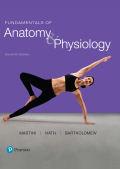
Fundamentals of Anatomy & Physiology (11th Edition)
11th Edition
ISBN: 9780134477336
Author: Martini
Publisher: PEARSON
expand_more
expand_more
format_list_bulleted
Question
Chapter 16, Problem 28CP
Summary Introduction
To identify:
The relationships between the nervous system and the body systems studied.
Introduction:
The human nervous system is a complex system that regulates the various activities of the body. It interacts with various organs and organ systems to control and coordinate their activities.
Expert Solution & Answer
Want to see the full answer?
Check out a sample textbook solution
Students have asked these similar questions
Please fill in all blank questions, Thank you
please fill in missing parts , thank you
please draw in the answers, thank you
Chapter 16 Solutions
Fundamentals of Anatomy & Physiology (11th Edition)
Ch. 16 - Prob. 1CPCh. 16 - Prob. 2CPCh. 16 - Prob. 3CPCh. 16 - Prob. 4CPCh. 16 - Prob. 5CPCh. 16 - Prob. 6CPCh. 16 - Prob. 7CPCh. 16 - Prob. 8CPCh. 16 - Prob. 9CPCh. 16 - Prob. 10CP
Ch. 16 - Name the two types of cholinergic receptors on the...Ch. 16 - Prob. 12CPCh. 16 - Prob. 13CPCh. 16 - Prob. 14CPCh. 16 - Prob. 15CPCh. 16 - Prob. 16CPCh. 16 - Prob. 17CPCh. 16 - Prob. 18CPCh. 16 - Prob. 19CPCh. 16 - Prob. 20CPCh. 16 - Prob. 21CPCh. 16 - Prob. 22CPCh. 16 - Prob. 23CPCh. 16 - Prob. 24CPCh. 16 - Prob. 25CPCh. 16 - Prob. 26CPCh. 16 - Prob. 27CPCh. 16 - Prob. 28CPCh. 16 - Prob. 1RQCh. 16 - Prob. 2RQCh. 16 - Prob. 3RQCh. 16 - Prob. 4RQCh. 16 - Prob. 5RQCh. 16 - Prob. 6RQCh. 16 - Prob. 7RQCh. 16 - What are the components of a visceral reflex arc?Ch. 16 - Prob. 9RQCh. 16 - Prob. 10RQCh. 16 - Prob. 11RQCh. 16 - All preganglionic autonomic fibers release _____...Ch. 16 - Prob. 13RQCh. 16 - Prob. 14RQCh. 16 - Prob. 15RQCh. 16 - Prob. 16RQCh. 16 - Prob. 17RQCh. 16 - Prob. 18RQCh. 16 - Prob. 19RQCh. 16 - Prob. 20RQCh. 16 - Prob. 21RQCh. 16 - Prob. 22RQCh. 16 - Prob. 23RQCh. 16 - Prob. 24RQCh. 16 - Prob. 25RQCh. 16 - Prob. 26RQCh. 16 - Prob. 27RQCh. 16 - Prob. 28RQCh. 16 - Prob. 29RQCh. 16 - Prob. 30RQCh. 16 - Prob. 31RQCh. 16 - Prob. 1CCCh. 16 - Prob. 2CCCh. 16 - Prob. 3CC
Knowledge Booster
Learn more about
Need a deep-dive on the concept behind this application? Look no further. Learn more about this topic, biology and related others by exploring similar questions and additional content below.Similar questions
- a. On this first grid, assume that the DNA and RNA templates are read left to right. DNA DNA mRNA codon tRNA anticodon polypeptide _strand strand C с A T G A U G C A TRP b. Now do this AGAIN assuming that the DNA and RNA templates are read right to left. DNA DNA strand strand C mRNA codon tRNA anticodon polypeptide 0 A T G A U G с A TRParrow_forwardplease answer all question below with the following answer choice, thank you!arrow_forwardplease draw in the answeres, thank youarrow_forward
- A) What is being shown here?B) What is indicated by the RED arrow?C) What is indicated by the BLUE arrow?arrow_forwardPlease identify the curve shown below. What does this curve represent? Please identify A, B, C, D, and E (the orange oval). What is occurring in these regions?arrow_forwardPlease identify the test shown here. 1) What is the test? 2) What does the test indicate? How is it performed? What is CX? 3) Why might the test be performed in a clinical setting? GEN CZ CX CPZ PTZ CACarrow_forward
- Determine how much ATP would a cell produce when using fermentation of a 50 mM glucose solution?arrow_forwardDetermine how much ATP would a cell produce when using aerobic respiration of a 7 mM glucose solution?arrow_forwardDetermine how much ATP would a cell produce when using aerobic respiration to degrade one small protein molecule into 12 molecules of malic acid, how many ATP would that cell make? Malic acid is an intermediate in the Krebs cycle. Assume there is no other carbon source and no acetyl-CoA.arrow_forward
- Identify each of the major endocrine glandsarrow_forwardCome up with a few questions and answers for umbrella species, keystone species, redunant species, and aquatic keystone speciesarrow_forward19. On the diagram below a. Label the three pictures as: DNA; polypeptide; or RNA. b. Label the arrows as: translation or transcription/RNA processing. c. Add the following details to the diagram. Promoter region TATA box Transcription start site Transcription terminator Intron (A,B,C,D) Exons (1,2,3,4,5) Splice sites 5' cap 5' UTR (untranslated region) 3' poly A tail 3' UTR (untranslated region) Translational start (AUG) Translational stop (UGA, UAG, or UAA) N and C ends of polypeptide 0000arrow_forward
arrow_back_ios
SEE MORE QUESTIONS
arrow_forward_ios
Recommended textbooks for you
 Medical Terminology for Health Professions, Spira...Health & NutritionISBN:9781305634350Author:Ann Ehrlich, Carol L. Schroeder, Laura Ehrlich, Katrina A. SchroederPublisher:Cengage Learning
Medical Terminology for Health Professions, Spira...Health & NutritionISBN:9781305634350Author:Ann Ehrlich, Carol L. Schroeder, Laura Ehrlich, Katrina A. SchroederPublisher:Cengage Learning Human Biology (MindTap Course List)BiologyISBN:9781305112100Author:Cecie Starr, Beverly McMillanPublisher:Cengage Learning
Human Biology (MindTap Course List)BiologyISBN:9781305112100Author:Cecie Starr, Beverly McMillanPublisher:Cengage Learning Biology (MindTap Course List)BiologyISBN:9781337392938Author:Eldra Solomon, Charles Martin, Diana W. Martin, Linda R. BergPublisher:Cengage Learning
Biology (MindTap Course List)BiologyISBN:9781337392938Author:Eldra Solomon, Charles Martin, Diana W. Martin, Linda R. BergPublisher:Cengage Learning Human Physiology: From Cells to Systems (MindTap ...BiologyISBN:9781285866932Author:Lauralee SherwoodPublisher:Cengage Learning
Human Physiology: From Cells to Systems (MindTap ...BiologyISBN:9781285866932Author:Lauralee SherwoodPublisher:Cengage Learning

Medical Terminology for Health Professions, Spira...
Health & Nutrition
ISBN:9781305634350
Author:Ann Ehrlich, Carol L. Schroeder, Laura Ehrlich, Katrina A. Schroeder
Publisher:Cengage Learning

Human Biology (MindTap Course List)
Biology
ISBN:9781305112100
Author:Cecie Starr, Beverly McMillan
Publisher:Cengage Learning

Biology (MindTap Course List)
Biology
ISBN:9781337392938
Author:Eldra Solomon, Charles Martin, Diana W. Martin, Linda R. Berg
Publisher:Cengage Learning

Human Physiology: From Cells to Systems (MindTap ...
Biology
ISBN:9781285866932
Author:Lauralee Sherwood
Publisher:Cengage Learning


Nervous System - Get to know our nervous system a bit closer, how does it works? | Neurology; Author: FreeMedEducation;https://www.youtube.com/watch?v=6O-0CVAgaEM;License: Standard youtube license